Where tradition meets celebration – The different festival colours of Uthralikavu Pooram
Uthralikavu has different vibrant colours. Sometimes it’s dark green, just before the paddy fields start blooming. The youth time of rice saplings later turn into yellowish shade when it is fully covered with rice seeds. Slowly it changes to yellow carpet and turns golden colour when the young seedlings turn ripen. During this season, at the time of sunset, Uthralikavu Sree Bhagavathy temple and its premises shine like melted gold. When nature casts its magical spell, at distant Akamala hills and Machad hills, chilled wind slowly blows. Even during noon, this wind never take rest.

This temple is a sacred grove, called ‘Kavu’ in Malayalam. Hills appear like umbrellas protecting the sacred grove, and the old nature is guarding it. Machad hill is situated in the east and Akamala hill in the west. A long railway line passes through South-North direction. On either side of the railway line lie the vast paddy fields. Uthralikavu Shri Rudhiramahakalikav temple is situated in the valley of Machad hill, surrounded by paddy fields. While you travel by train between Shornur and Vadakkanchery, you can see Uthralikavu where history and folklore reside together.
The story connecting landlord Kelathachan and Mookambika
Decades back, there was a landlord called Kelathachan who was a great devotee of Mookambika. His provinces came under old Cochin Kingdom. Those days he used to visit Mookambika, and it took 2 months for him to complete the visit. When he started aging, it became difficult for him to travel such long distance to reach the temple. During one such visit, he expressed his worries to the goddess and the Goddess came along with him mounted on his umbrella. He put his umbrella in Mullaykkal, a place near to landlord’s ancestral home. It was first time he placed his umbrella somewhere, after returning from Mookambika. He was inspecting his fields when he did this, but was not able to lift the umbrella later.
Kelathachan’s cook’s name was Palliyath Nair. Sometimes goddess used to reside in him and he turns to Komaram/Velichapad, where he used to perform with his spatula, making it his sword. One day landlord beat him with broom. But his hands got burned and he became still. So Kelathachan sought the help of an astrologer and performed a prashnam. The astrologer found the presence of goddess Mookambika there and told the landlord.
Later the divine presence of goddess was found in the valley of Akamala Hills, inside the paddy fields, beneath an Indian Tulip tree (called Poova maram in Malayalam). While a woman named Uthrali was cutting grass from the fields, her sickle incidentally rubbed a rock and it started bleeding. Thus the goddess showed her presence through blood. This site, now called Mullakal Sreemoolasthanam, the abode of goddess.
Now also, during Para Purappad ceremony, the first para (a kind of offerings given to goddess in a traditional measuring can; you can read more about Para here) is from the ancestral home of Kelathachan. Uthralikavu Pooram, the second biggest Pooram (temple festival) after Thrissur Pooram is also known for its importance given to Harijan Vela (A temple custom performed by Harijans). Traditional art forms namely Aandi, Poothan, Thira, Mookkam Chathan and Nayaadi are performed as a part of annual temple celebrations, in front of the goddess.
The presiding diety is Rudhira Mahakali. For the blessings given by the Goddess, the temple festival is a form of expressing gratitude by the locals. The latest member of Kelathachan’s family is Kelath Parvathi Valiamma.
Poova Maram seen now was planted by Chinnan Menon of Kumaranallur desam

The installed deity is in the form of Vaalkannadi, a type of traditional Kerala mirror with a handle. It’s made of stone. During the Kerala floods of 1924, the Indian Tulip tree (Poova maram) under which the presence of goddess was spotted, was uprooted. It was located close to Sree Kovil, the place where the deity was installed. The surprising fact is, it didn’t damage the temple or deity.
Latter a tree of same species was planted by Chinnan Menon belonging to Ayyath Kizhekkekara family of Kumaranallur desam (village), which still is there. As of now, it is 100 years old. Chinnan Menon belonging to a rich family was a great devotee of the goddess, who even left family to serve her.
Thidamb (Idol) used by Kumaranallur desam for annual temple procession is still kept with the same family ancestral house. There is a perpetual lamp (kedaavilakk) placed inside the worship room of the home, and the family members believe it to be their fortune to get such a great opportunity to keep Thidamb of the Goddess. Satish Kumar, the son of Ammootty Amma, the senior most member of the family currently serves as the first president of the coordination committee representing 3 deshams (villages).
The position of ‘Komaram’ still held by the cook’s family
The position of ‘Komaram’ the temple festivals was given to the family of Palliyath Nair, the cook by Kelathachan. Many families have passed on. Still now this right is reserved to same family. Palliyath Madhavan Nair is currently holding the position of Komaram for the temple festival. Still now there are bundles of old palm leaves scripts kept in the storage space of upper floor of the family. Newer generations haven’t referred any of these old palm leaves scripts which contain mantras, rituals, medical treatments, sorcery, black magic etc. All these handwritten works (manual scripts) have been tied together and kept safe in the upper storage of the ancestral home.
In the pooja rituals of Uthralikavu, Komaram holds a special place. It starts with the Nirapara offerings given by devotees at homes, and includes many more rituals like Kalasa Nivedyam of Kunjootty Moothar. Kunjootty Moothar, who lived in the locality a few generations back, is believed to be a representative of God, and was visible to everyone. Through Bhagavathi Seva he showed many miracles, tricks and magic. But after sometime he took full control over Bhagavathi, and later disappeared as a mystery, as told by the locals. Yet near to the temple, daivathara (a special space for worship) has been built for him. Before the temple festival begins, as a custom, locals offer Nedyam to please him at daivathara, and this ritual is performed by Komaram.
Komaram lives alone in a home. He grows his hair, and lives as a worshipper of goddess, spending time in meditation and prayer. This home is near to Palliyath Tharavadu (ancestral home). There is a daivathara in the home premises, where Komaram worships. Every evening a lamp is lighten at the terrace (where the old scripts are kept) of the home and that lamp is used to light daivathara below. For the last four decades Komaram Madhavan Nair is doing all these rituals.
A strong belief that the goddess will remove all obstacles
Though worship in Mookambika Temple is done by Adiga priests, in Uthralikavu it’s done by brahmins belonging to another village. Now the main priest of the temple is Gopalakrishna Iyer from Kasaragod. Earlier his father Ramayyar served as the main priest. When Ramayyar turned old, his son took over the duty. This Rudra Maha Kali Kavu’s divinity and power excel among all Rudra Mahakali temples of Kerala.
Pantheerunaazhi Payasam is the main offering of the temple. Muttarukkal is another important offering. It is done by devotees to remove obstacles. ‘Mutt’ means ‘obstacles’ and ‘Arukkal’ means ‘to get rid of’. The devotee imagines that different obstacles like Dehamutt (for body), Vidyamutt (for education) and Karmamutt (for Karma) are invoked into a coconut, and then it is broken in Guruthi Thara (a stone place built for breaking coconuts) in front of the shrine. Devotees can also give Divasa pooja (Daily Pooja) dedicating some Poojas for a day.
Niramala can be done 365 days a year. All the lamps in the chuttuvilakku around the temple can be lighted (by a single person) as an offering. But you may need to wait for at least a few months to get your Niramala done. You can simply book it earlier. In the evenings, it’s a spectacular sight to watch the temple from long distance, standing in the paddy fields, when Niramala is lighted. Uthralikavu appears like a cluster of stars from distance.
Nirapara tradition is an integral part of the rituals & offerings
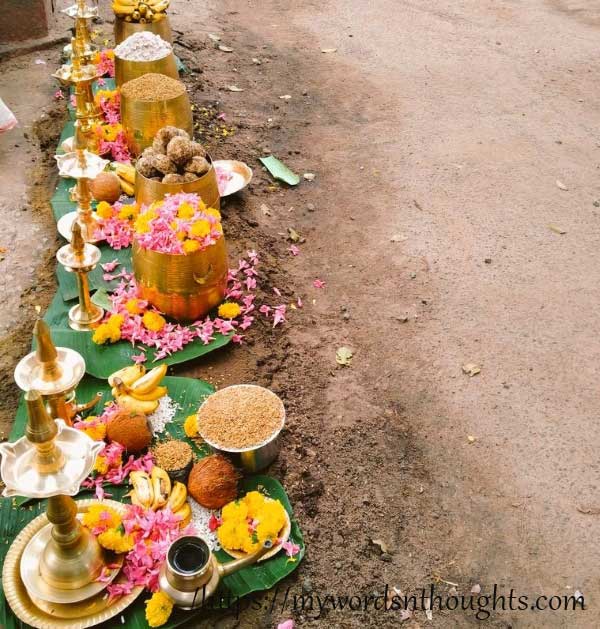
Rice, Malar (puffed rice), jaggery and turmeric – Para of Uthralikavu is very famous. Maybe because the temple is surrounded by paddy fields, giving rice as offering (called Aripara) to the Goddess is very significant. Turmeric para is also significant. During the festival seasons, the para offering is done at homes. The procession reaches homes, and the para offerings accepted from there. The families light Kerala lamps and welcome the procession. Komaram also blesses the family members.
The Parayedupp (accepting/taking Para from home) is accompanied by some traditional art forms also, done by some performing artists. Kali, Darikan, Bhuta gana etc are some of the characters presented as art forms by the artists. They accompany the Komaram and his group, and perform after they leave the homes. This ceremony is held from Tuesday to Tuesday. Kavu theendal ceremony is conducted on Pooram star of Kumbham month in Malayalam calendar. Nirapara or simply Para is an offering given by devotees to temples, and in Thrissur district where Uthralikavu belongs to, it’s conducted in a vibrant and elaborated way comparing other districts. If you want to know more about this ritual, click here.
The paddy fields around the temple belong to different people. But centuries have passed, but still none of its owners have sold to other people or used for farming other agricultural products. They didn’t even use the fields for any other purposes and still now paddy is cultivated. Thus temple situated inside the paddy fields has become a cultural landmark over the decades, and the whole premises along with the greenery attracts everyone. And the credit also goes to those people who hold this land, and believe it to be their responsibility to keep the beauty of the place intact.
There are many artists who received blessing of the goddess
P. N. Menon from Engakaadu and his nephew Bharathan are among those artists who received the blessing of Uthralikavu Bhagavathi. Both are acclaimed filmmakers who gave immense contributions to Malayalam cinema. Near to his ancestral home, director Bharathan has built a mandapam in the paddy fields, which is still seen there. It was built in such a way that both Machad Hills in the east and the green paddy fields leading towards Engakadu temple can be seen at the same time from this Mandapam.
Many of Bharathan’s friends frequently visited Vadakkanchery and nearby places. Nedumudi Venu, Innocent, Oduvil Unnikrishnan, Pavithran and Kaithapuram Damodaran Namboothiri where among those. Oduvil Unnikrishnan has composed and released one devotional musical album dedicated to the Goddess of Uthralikavu. Kaithapuram has got inspiration for a few of his songs from this temple and its premises. His popular songs, “Kannethaa Dooram Marutheeram” from Thaazhvaram and “Uthralikavile Pattola Panthalil” from Vidhyarambham are among those.
A pooram of different desams

In the Pooram maidan, Poothan, Thira, Aandi, Aandi Kidav and Shankara Nayadi dances in their colourful costumes, with vibrant footsteps. The festival begins with the ceremony of ‘Para Purappadu’, and it is conducted on the Tuesday coming after the first Friday of Malayalam month Kumbham. It comes during February-March season of English calander. Every Pooram is an association of different desams belonging to the same village and it’s a get-together of old friends and relatives, who visit their ancestral homes during festival season.
Uthralikavu Pooram is conducted by 3 desams (regions) – Engakadu, Kumaranellur and Wadakkanchery. The pooram overflows through these three desams. Each Desam has the right to use 11 elephants for their procession. On the final day of Pooram, where will be 33 elephants belonging to three desams participating in the grand event. They will be roaming in around 10 km total surface area from the temple. Uthralikavu Pooram is counted among the five major Temple festivals of Kerala, and in terms of grandeur, it comes behind Thrissur Pooram – the biggest temple festival of Kerala.
As told before, the major event of the procession of elephants is conducted on second Tuesday, coming after the first Friday of Kumbham. On first Tuesday, temple celebrations kick off. Sample fireworks is conducted on Sunday every year, 2 days prior to Pooram. Same day, Altharamelam is also conducted by the coordination of all the three desams. The air will be filled with the music of Panchavadhyam and Pandimelam. On Monday Aanachamaya Pradarshanam is conducted, where ornaments and accessories of elephants used in Pooram are displayed. On Tuesday, 12 Fireworks are conducted by three desams in a grand way.
Kaliyattam is conducted for one or two days in any one of the desams, during the festival season. Young people take Vritham for 7 days to participate in this Theyyam. Collecting accessories like Patta (decorative headgear or ornamental band) & Kuruthola (tender coconut leaves) for Choott are conducted in a grand way. Choott is the bundles of dried coconut and palm leaves that are tied around the waist, arms, or other parts of the performer’s body.
Pandal is another attraction of this festival. Multi-storey pandal of great height is built together by three desams. Kerala’s most famous and celebrated elephants are brought here for Pooram. The display and procession of all elephants together at a place known as Koodiyezhunnallath is conducted in the evening of Tuesday. When all the caparisoned elephants are displayed together in a place under the setting sun, it’s majestic, grand and beautiful. Same is the case of Panchavadhyam led by experienced and celebrated artists, which accompanies the elephant display.

Last ceremony is ‘Upacharam Cholli Piriyal’, where the goddesses representing each Desam say goodbye to each other. After that everyone leave the place, and Uthralikavu goddess stays there inside the paddy fields. Yes, if you visit this place once, you will definitely wait for another occasion when you can come here again. Now a film song written by Kaithapram is coming to my mind, and I am ending this article by quoting its first few lines.
“Uthralikkavile Pattolappanthalil
Kulirambili Valayangal Thoranamayi
Manjila Thumbikale Konjiyunarthan
Aniyarayil Pooppada Than Aravamayi”
Also read a brief article about Uthralikavu Pooram in Malayalam.


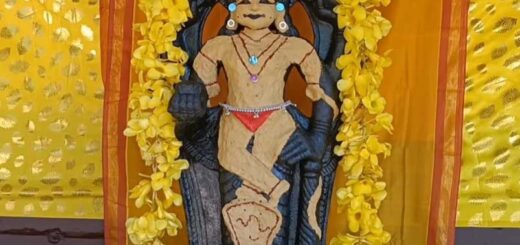
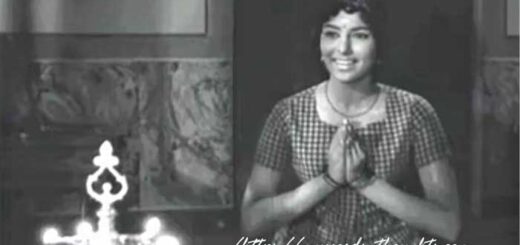



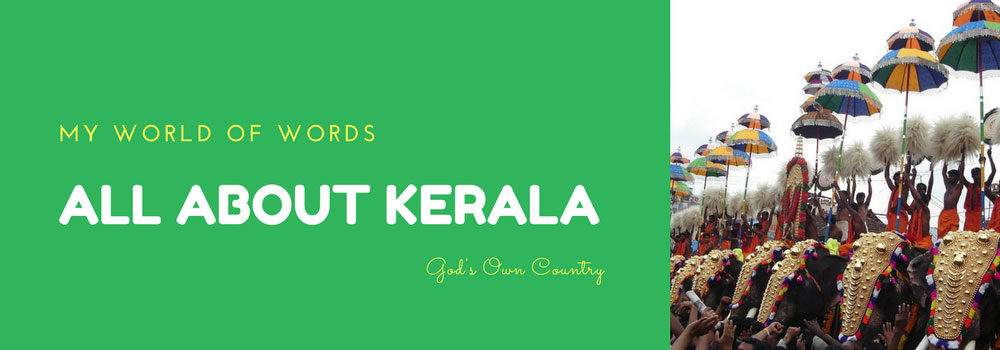
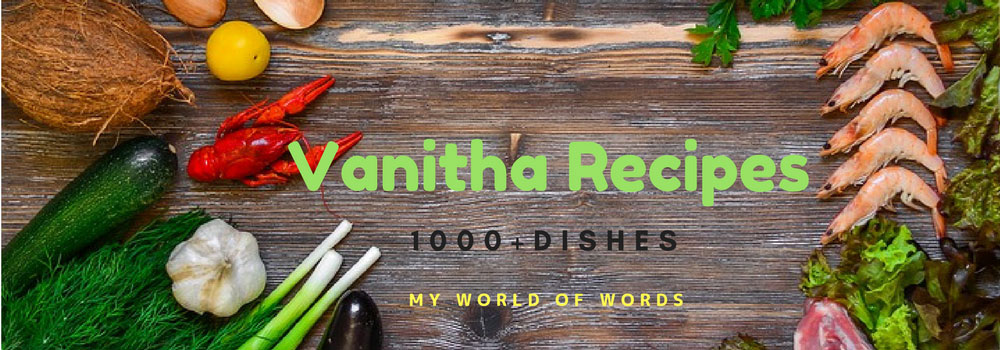
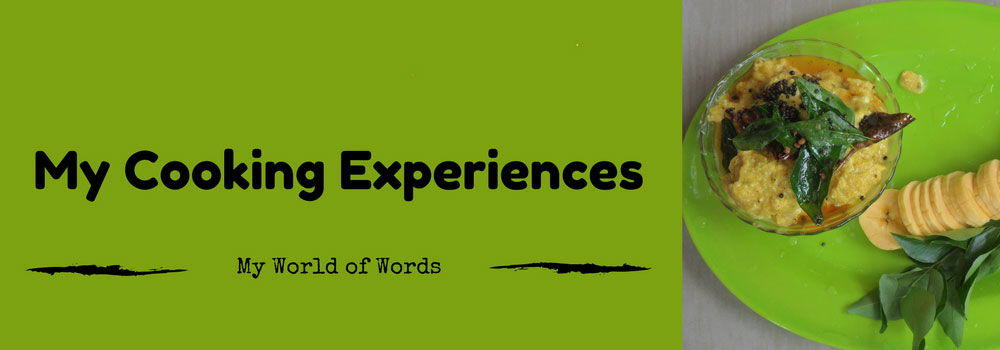


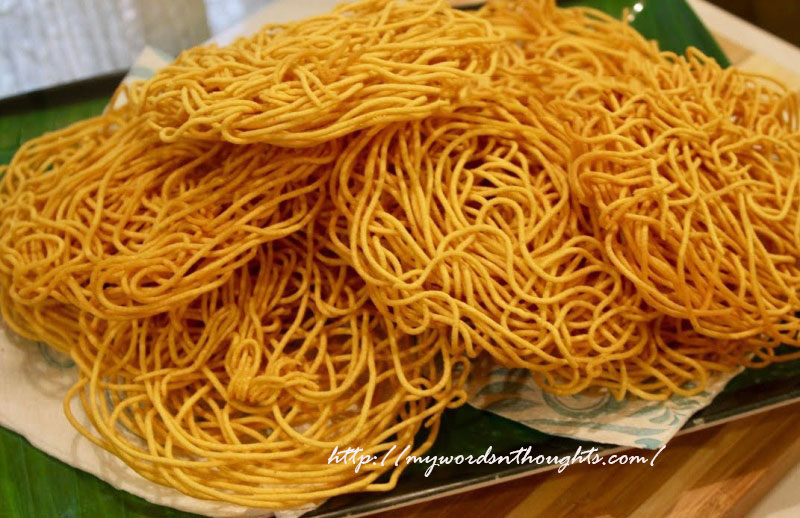

Recent Comments